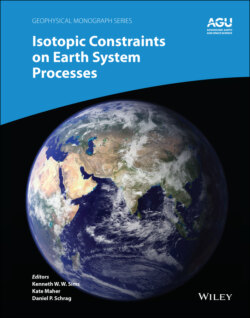Читать книгу Isotopic Constraints on Earth System Processes - Группа авторов - Страница 25
1.2.4. Thermal (Soret) Diffusion Coefficients
ОглавлениеThe flux equation of a system that is inhomogeneous in both composition and temperature will have terms proportional to both the chemical gradient and the temperature gradient. Expanding the binary diffusion representation of the flux to include the effect of a temperature gradient results in a binary flux equation of the form (Tyrell, 1961)
Figure 1.1 Normalized concentration of CaO, MgO, K2O, FeO, and SiO2 measured across glass recovered from a molten rhyolite‐basalt diffusion experiment are superimposed to show the similarity of the effective diffusivity of all the major oxide components. For the purpose of this comparison, the concentration differences were normalized by (C‐CL)/(CH‐CL), where C is the concentration of a component along the profile, CL is its concentration in the low end‐member, and CH is its concentration in high end‐member.
Figure taken from Richter et al. (2003).
(1.6)
where ρ is the bulk density, is the effective binary diffusion coefficient of i in a mixture of components i and j, Xi and Xj are the mass fractions of i and j, and σ i is the Soret coefficient. For present purposes, the term “Soret diffusion” will be used when the mass transport in a silicate liquid is due to fluxes driven by both chemical and temperature differences.
